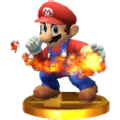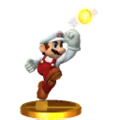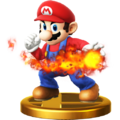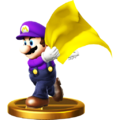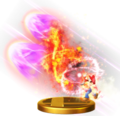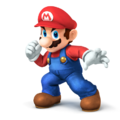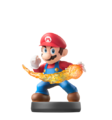Mario (SSB4)
| Mario in Super Smash Bros. 4 | |
|---|---|
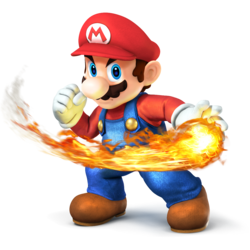 
| |
| Universe | Mario |
| Other playable appearances | in SSB in Melee in Brawl in Ultimate |
| Availability | Starter |
| Final Smash | Mario Finale |
| Tier | A (9) |
Mario (マリオ, Mario) is a playable character in Super Smash Bros. 4. He was confirmed on June 11th, 2013 during the E3 2013 Nintendo Direct.[1] He was also one of the main subjects of the Developer's Direct for Super Smash Bros. later during E3 2013.[2] He was among the first wave of amiibo figurines for Smash 4. Charles Martinet's portrayal of Mario from Super Smash Bros. Brawl was repurposed for Smash 4.[3]
Mario is currently ranked 9th out of 55 characters on the tier list, in the A tier, which is at the lower end of the top tier. This is his best tier placement to date, and a significant improvement from his 31st out of 38 ranking Brawl where he stood at the top of the bottom tier and is the fifth highest ranking veteran. Mario's greatest strength is his effective frame data; most of his moves have little startup lag and have relatively low end lag. This results in Mario being fairly difficult to punish relative to most of the cast. His combo game, while not as versatile compared to Luigi or Sheik, is nevertheless potent, as Mario can rack up damage quickly and reliably, most notoriously with his down throw into multiple up tilts. He also has a versatile moveset: a disruptive projectile in his Fireball, a reflection-based and reverse-based move in his Cape that can counteract camping, and a decent, if niche edgeguarding option with F.L.U.D.D..
Despite being buffed significantly from Brawl, Mario has several weaknesses. Mario's overall range is below average, giving him trouble against characters with long disjointed range such as Cloud and Marth. Furthermore, he cannot effectively outcamp other characters, due to Fireball being relatively slow compared to some other projectiles in the game. Mario also suffers from a lack of consistent KO setups, and along side his short frame and relative floatiness for a middleweight, a weakness to rage setups. Mario's average attributes do not allow him to quickly gain an advantage either, as the strengths of other characters can contest his, with the most notable being his overall mobility.
Due to his lack of severe weaknesses, as well as one of the lowest technical curves in the game, Mario has had among the highest representation in tournaments, and has achieved excellent results at top level play. Owing to Mario's incredible tournament placings, especially during the summer of 2016, many smashers have viewed Mario as one of the best characters in the game and possibly deserving of an even higher ranking on the tier list; ESAM, for instance, has notably argued that Mario is the best character in Smash 4, while others claim that Mario should be lower due to his not as dominant results and his glaring range issues.
Attributes
Like in the majority of his games and spin-offs, Mario is intended to be a balanced character in terms of attributes, possessing average walking, dashing and falling speeds, air acceleration, gravity and weight. However, he also has high air speed and jumping force, but low traction. These balanced stats do not give Mario the edge when it comes to overall movement, but they nevertheless make him adept at most situations where a key attribute is needed to gain the advantage, which when combined with his very quick frame data, grants Mario a very effective neutral game. As a result, despite his attributes implying a jack-of-all-trades type of character, Mario is more of a rushdown character in practice.
Thanks to his incredibly quick attack speed, Mario shines in close-quarters combat, as few other characters like Sheik and Meta Knight are a match for this speed. His fast attack speed allows him to consistently apply pressure to the opponent, and he's capable of quickly racking up damage once he gets the momentum, which is easy to do so on characters that cannot match his attack speed without getting heavily punished for it, like Palutena. Excluding his forward smash, forward aerial and special moves, all of Mario's moves have fast startup and low ending and landing lag (the latter in the case of his aerial attacks). All of his grounded moves are prime examples of his quick frame data: his neutral attack is his fastest move and an overall effective way to rack up damage, along with handy combo capabilities, while his up and down tilts are very effective combo starters that can help rack up plenty of damage, and the former easily chains into itself at low percentages, as well as being hard to escape. All of his smash attacks are excellent KO options, as they can reliably KO at high percentages without being endlag-heavy; his forward smash has the highest power of all of his smash attacks when sweetspotted, down smash is a semi-spike, making it useful for forcing opponents offstage, and up smash is very hard to punish due to its speed, power and the fact it grants intangibility on his head.
Mario's aerial attacks are also very useful in many cases. Neutral aerial is a sex kick that can be useful in edgeguarding or for breaking combos. Back aerial has the longest reach and the highest knockback of Mario's aerial moves, allowing it to space effectively and reliably KO offstage. Up aerial's extremely quick startup, vertical launch angle and lack of sourspots let it combo into itself or other moves, on top of letting it easily break combos and setup the aforementioned. Down aerial is a great anti-juggling move that can also KO if used near the top blast line. It also benefits from frame cancelling, as its moderate landing lag is reduced, allowing for potential follow-ups. Finally, his forward aerial is a meteor smash with high base knockback for one, making it great for gimping all but the farthest reaching of recoveries.
His special moveset is highly varied and has plenty of uses. Fireball is a projectile with decently long range. It can be useful in the neutral game or in edgeguarding, thanks to its disruptive knockback, along with very useful chances to disrupt direct approaches. Super Jump Punch travels in a controllable diagonal direction and grants moderate distance, making it good at recovery. It also has intangibility upon startup, allowing it to be used out of shield very effectively. Due to its extremely quick startup, it is also a useful combo finisher, especially near the blast line. On the other hand, Cape reverses opponents, with the induced disorientation often being enough to allow a free hit or efficiently gimp a recovery, which aids in edgeguarding opponents. It is also a powerful reflector, making it highly useful in matchups against projectile-heavy characters, such as Mega Man. F.L.U.D.D. is a mechanism that shoots water, pushing opponents away, which compliments his Cape. Though situational, it can occasionally be used to give Mario some breathing space. As a result of his Cape, F.L.U.D.D. and his fast aerials, Mario also boasts a versatile edgeguarding game.
Another valuable strength of Mario is his grab game. Even though his grab reach is only average, his grabs are among the fastest in the game, and his pummel, while moderately slow, can rack up some damage before throwing the opponent. His forward and up throws have the same overall use: they send the opponent at a disadvantageous position, where Mario can capitalize on their mistake. His back throw is by far his strongest throw and can reliably KO below 150% near the ledge on any character, and even earlier with rage. Finally, his down throw is a notorious combo starter. It can repeatedly lead into up tilt at low percentages, or down tilts to regrab on fast fallers or heavyweights and rack up at least 20% in the process. Alternatively, it can lead into neutral attack, forward tilt, down tilt, up smash and down smash at low percentages, as well as neutral aerial, up aerial, down aerial and Super Jump Punch at medium percentages. Finally, and due to the favorable angles his moves send at, his tremendously quick frame data and his extensive amount of combo starters, Mario's combo ability is among the most reliable in the game, and it is also worth noting that seven of Mario's moves can lock (forward tilt, neutral attack's first two hits, Fireball, down aerials landing hit, and neutral, forward and back aerials (the former and latter being usually effective when sourspotted, though a majority of them are only usable at low percents). This makes it almost always imperative for Mario's opponent to tech all attacks at low percentages when needed, otherwise Mario can capitalize on the opportunity, and tack on unavoidable massive damage in the process.
Despite Mario's numerous strengths, he is not flawless. Most characters are able to outperform him in various areas: notable examples include Bayonetta having a more versatile combo ability, Sonic having better mobility, Donkey Kong having higher power right off the bat and Cloud having larger reach. In particular, the latter two are his main weaknesses: his KOing ability is largely inconsistent, with very few guaranteed KO set-ups, and all of them being hard to confirm. While much of his moveset can get the job done, there is a noticeable gap in power between his strongest moves and his other ones, with this meaning he'll usually have to rely on his sweetspotted forward smash, up smash, down smash's back hit, or back throw to score kills, which are all further compounded by the poor reach of his attacks. As such, he cannot afford to get predictable, especially with the existence of stale-move negation. His lack of reach also prevents him from fighting at a safe distance and consistently forces Mario to approach characters. This leads into having some difficulty against characters with large or disjointed reach, though fortunately, these types of characters tend to have significantly slower attacks than Mario, meaning that this tends to be the least of his worries.
Lastly, his recovery is rather limited. He has fast air speed, a high jump, and a very fast and safe up special in Super Jump Punch. However, Super Jump Punch does not travel a very long distance and is fairly linear, making it easy to predict. His other options also are unreliable, as Cape and F.L.U.D.D. each travel very little momentum and are extremely easy to edgeguard, F.L.U.D.D. being useful only to substitute for his air speed, and Cape only to guard break edgeguarders or wait them out. This necessitates that Mario returns to the stage quickly, as a single opening offstage may be fatal for him. Nevertheless, Mario's recovery provides serviceable distance, but caution must be exercised when offstage.
Mario's custom moves define the fundamentals of customization, with all of them following an "X over Y" pattern. Fast Fireball deals less damage and barely causes flinching, but covers more range at a much faster pace and can further improve his already above average camping abilities as well as disrupt most attacks. Fire Orb has less range and is much slower, but deals repeated damage and lingers after being shot, allowing for potential follow-ups. Shocking Cape is electric and has actual KO power, but cannot stall in the air as much as its other variants or reflect projectiles. Gust Cape pushes opponents away, especially at point-blank range, but it deals less damage and possesses more ending lag. Super Jump grants almost twice as much distance, but is unable to hit opponents. Explosive Punch deals high flame damage, but travels a short distance at a fixed direction. Scalding F.L.U.D.D. hits multiple times and can disrupt an opponent's approach better, but is not as useful in edgeguarding and has less reach. High-Pressure F.L.U.D.D. takes much longer to charge, but its push effect is greatly amplified.
Overall, Mario has many clear strengths, and very few glaring weaknesses. Despite being intended as a jack-of-all-trades character, his very quick speed overall and largely reliable combo ability allows him to get the edge easily against most characters, as it is hard to escape from him once he gets to combo the opponent, while being easy for him to escape and regain the advantage. However, because of his low range, Mario must almost always fight in close quarters. Mario has to be very careful offstage as well in spite of his viable edgeguarding game, as a single vent in his defenses can cause him to be unable to recover.
Nevertheless, Mario's favorable attributes give him numerous advantages. Because of this, he has the one of, if not the, lowest technical learning curves in the game, which has secured him high representation in all levels of play, with high-level professionals such as Ally and ANTi achieving a slew of strong tournament results.
Changes from Brawl
Mario has been significantly buffed from Brawl, where he was a bottom tier character. He is considerably nimbler and stronger than in past games, and is much more capable of comboing and KOing. His reach is somewhat greater as well. Additionally, as many characters with disjointed hitboxes who were a large threat to Mario in Brawl, such as Marth, were nerfed or reworked, Mario has an easier time handling them than in previous games, thanks to his better reach. Furthermore, the change to the ledge mechanics makes his linear recovery harder to edgeguard. Lastly, in tournaments and other situations where custom specials are available, his edge-guarding game is improved further with tools such as Fast Fireball, Gust Cape, and High-Pressure F.L.U.D.D., all of which are potent at gimping.
However, Mario received one significant nerf. Despite his combo game and KO potential improving greatly, Mario's damage output has now been decreased noticeably, now being average. When combined with his few KO setups and below average range, it is much harder for Mario to score KOs. Regardless, however, Mario has received major buffs to his maneuverability and combo game, and he is considered to be one of the most potent choices for competitive play, courtesy of being easy and effective to use for beginners and advanced players alike. This has also resulted in him having the largest tier rise from Brawl.
Aesthetics
 Due to the aesthetic used in SSB4, Mario has a sleeker design, and his overall color scheme is more vibrant. These changes make him appear virtually identical to his appearance as of Super Mario 3D Land.
Due to the aesthetic used in SSB4, Mario has a sleeker design, and his overall color scheme is more vibrant. These changes make him appear virtually identical to his appearance as of Super Mario 3D Land. Mario's blue alternate costume has been updated. His hat and overalls are now cyan, while his shirt is now pink. These changes make it resemble Mario's attire on Mario Bros.' Japanese box art. Additionally, Mario's yellow alternate costume has been slightly updated. The "M" on his cap is now green, instead of blue. Lastly, Mario has received two new alternate costumes. The first is based on his appearances in Family Computer Golf: U.S. Course and NES Open Tournament Golf, while the second is based on Waluigi.
Mario's blue alternate costume has been updated. His hat and overalls are now cyan, while his shirt is now pink. These changes make it resemble Mario's attire on Mario Bros.' Japanese box art. Additionally, Mario's yellow alternate costume has been slightly updated. The "M" on his cap is now green, instead of blue. Lastly, Mario has received two new alternate costumes. The first is based on his appearances in Family Computer Golf: U.S. Course and NES Open Tournament Golf, while the second is based on Waluigi. The sounds Mario's up taunt makes are similar to the sounds heard when powering-up and getting hit or using a pipe in Super Mario Bros.
The sounds Mario's up taunt makes are similar to the sounds heard when powering-up and getting hit or using a pipe in Super Mario Bros. Mario's chest faces the foreground regardless of whether he's facing left or right.
Mario's chest faces the foreground regardless of whether he's facing left or right. Mario's dash attack (while holding an item) has slightly changed: Mario now holds the item in one hand as opposed to two.
Mario's dash attack (while holding an item) has slightly changed: Mario now holds the item in one hand as opposed to two. Mario is significantly more expressive.
Mario is significantly more expressive.
Attributes
 Mario has significantly increased air speed (0.94 → 1.15), going from tied for 19th fastest in Brawl to tied for 9th fastest in SSB4. This significantly improves his recovery, going from subpar to above average, as its speed makes it hard to punish. It also improves his combo potential noticeably.
Mario has significantly increased air speed (0.94 → 1.15), going from tied for 19th fastest in Brawl to tied for 9th fastest in SSB4. This significantly improves his recovery, going from subpar to above average, as its speed makes it hard to punish. It also improves his combo potential noticeably. Mario dashes faster (1.5 → 1.6).
Mario dashes faster (1.5 → 1.6). Mario jumps higher.
Mario jumps higher. As with the majority of the cast in its transition from Brawl, Mario's falling speed has been increased (1.28 → 1.5). This makes Mario less susceptible to juggling and vertical KO's, as well as improving his overall mobility, though it also makes him more susceptible to combos.
As with the majority of the cast in its transition from Brawl, Mario's falling speed has been increased (1.28 → 1.5). This makes Mario less susceptible to juggling and vertical KO's, as well as improving his overall mobility, though it also makes him more susceptible to combos. Mario's gravity is higher (0.075 → 0.08715), worsening his vertical endurance, but improving his air mobility.
Mario's gravity is higher (0.075 → 0.08715), worsening his vertical endurance, but improving his air mobility. Mario's traction has been significantly decreased, going from being tied for the eleventh best out of 39 characters to the sixth worst out of 58 (0.06 → 0.045), which makes it harder for him to punish out of shield.
Mario's traction has been significantly decreased, going from being tied for the eleventh best out of 39 characters to the sixth worst out of 58 (0.06 → 0.045), which makes it harder for him to punish out of shield. The changes to hitstun canceling make combos more viable, a fact which Mario has been able to make great use of.
The changes to hitstun canceling make combos more viable, a fact which Mario has been able to make great use of.
Ground attacks
 Neutral attack, forward tilt, up tilt, and dash attack deal less damage (9% → 8% (neutral attack), 8% → 7% (forward tilt), 7% → 5.5% (up tilt), 9% clean/7% late → 8%/6% (dash attack)).
Neutral attack, forward tilt, up tilt, and dash attack deal less damage (9% → 8% (neutral attack), 8% → 7% (forward tilt), 7% → 5.5% (up tilt), 9% clean/7% late → 8%/6% (dash attack)). All hits of neutral attack have more ending lag (frame 16 → 20 (hit 1), frame 19 → 22 (hit 2), frame 30 → 34 (hit 3)), with the third hit also having a shorter duration (frames 7-10 → 7-8).
All hits of neutral attack have more ending lag (frame 16 → 20 (hit 1), frame 19 → 22 (hit 2), frame 30 → 34 (hit 3)), with the third hit also having a shorter duration (frames 7-10 → 7-8). Neutral attack's last hit has altered knockback (30 (base)/95 (scaling) → 45/80).
Neutral attack's last hit has altered knockback (30 (base)/95 (scaling) → 45/80). Forward tilt has a shorter duration (frames 5-7 → 5-6), more ending lag (frame 25 → 31) and no longer has higher base knockback when angled down (13 → 8), making the move less safe on hit at low percents.
Forward tilt has a shorter duration (frames 5-7 → 5-6), more ending lag (frame 25 → 31) and no longer has higher base knockback when angled down (13 → 8), making the move less safe on hit at low percents. Forward tilt's lower damage and knockback allows it to lock for longer.
Forward tilt's lower damage and knockback allows it to lock for longer. Up tilt deals noticeably less knockback as a result of its decreased damage, which drastically increases its comboing and juggling ability, to the point of being able to deal around 25% damage on most characters if used repeatedly, and allowing it to combo into aerials until high percents.
Up tilt deals noticeably less knockback as a result of its decreased damage, which drastically increases its comboing and juggling ability, to the point of being able to deal around 25% damage on most characters if used repeatedly, and allowing it to combo into aerials until high percents. Due to its reduced knockback, up tilt is no longer a reliable KO move.
Due to its reduced knockback, up tilt is no longer a reliable KO move. Mario no longer smiles during his up tilt.
Mario no longer smiles during his up tilt. Down tilt has less ending lag (frame 35 → 28), allowing it to be a viable combo starter at low percents.
Down tilt has less ending lag (frame 35 → 28), allowing it to be a viable combo starter at low percents. Down tilt has increased base knockback (20 → 35). While this improves its combo potential at lower percents with the changes to hitstun canceling, it also worsens it at higher percents.
Down tilt has increased base knockback (20 → 35). While this improves its combo potential at lower percents with the changes to hitstun canceling, it also worsens it at higher percents. Dash attack deals more knockback (70 base/50 scaling (clean), 45 base/30 scaling (late) → 100/43 (both)) and both its clean and late hit have consistent angles (110°/80° → 60° (clean), 120°/70° → 110° (late)). The changes to hitstun canceling also grant the late hit followups when combined with the move's lowered damage output.
Dash attack deals more knockback (70 base/50 scaling (clean), 45 base/30 scaling (late) → 100/43 (both)) and both its clean and late hit have consistent angles (110°/80° → 60° (clean), 120°/70° → 110° (late)). The changes to hitstun canceling also grant the late hit followups when combined with the move's lowered damage output. Forward smash has more knockback scaling especially on its sweetspot (100/90 → 103/99), and deals more damage when angled down (13% (arm)/16% (fire) → 14.42%/17.51%), improving its KO potential. Its sourspot can also no longer send opponents behind Mario, preventing it from unexpectedly launching them in the wrong direction for KOing, and uses a single extended hitbox that covers less horizontal distance, making the sweetspot easier to land.
Forward smash has more knockback scaling especially on its sweetspot (100/90 → 103/99), and deals more damage when angled down (13% (arm)/16% (fire) → 14.42%/17.51%), improving its KO potential. Its sourspot can also no longer send opponents behind Mario, preventing it from unexpectedly launching them in the wrong direction for KOing, and uses a single extended hitbox that covers less horizontal distance, making the sweetspot easier to land. Forward smash deals less damage when angled up (15% (arm)/18% (fire) → 14.7%/17.85%).
Forward smash deals less damage when angled up (15% (arm)/18% (fire) → 14.7%/17.85%). Up smash has slightly more knockback scaling (90 → 94). Coupled with the weakening of DI for moves with vertical angles, this improves its KO potential.
Up smash has slightly more knockback scaling (90 → 94). Coupled with the weakening of DI for moves with vertical angles, this improves its KO potential. Up smash has a shorter duration (frames 9-14 → 9-12) with no change in animation, reducing its range in front of Mario.
Up smash has a shorter duration (frames 9-14 → 9-12) with no change in animation, reducing its range in front of Mario. Down smash's back hit deals much more knockback (35 base/75 scaling → 30/100), making it a viable KO option at high percents. Additionally, both hits of the move are now semi-spikes (361° → 32° (hit 1)/30° (hit 2)), significantly improving its edgeguarding ability.
Down smash's back hit deals much more knockback (35 base/75 scaling → 30/100), making it a viable KO option at high percents. Additionally, both hits of the move are now semi-spikes (361° → 32° (hit 1)/30° (hit 2)), significantly improving its edgeguarding ability. Down smash's front hit deals much less damage (15% → 10%), making it much weaker despite its knockback now being equal to that of the back hit (40 (base)/73 (scaling) → 30/100). The move also has more ending lag (frame 38 → 44).
Down smash's front hit deals much less damage (15% → 10%), making it much weaker despite its knockback now being equal to that of the back hit (40 (base)/73 (scaling) → 30/100). The move also has more ending lag (frame 38 → 44).
Aerial attacks
 All aerials except forward aerial deal less damage (10% → 8% (neutral, clean), 12% → 10.5% (back, clean), 11% → 7% (up), 7% → 5% (down, final hit)). Their knockback, however, has been compensated except for neutral aerial (10 base/95 scaling → 12/106 (back), 9 base/100 scaling → 10/135 (up), 80 scaling → 100 (down, final hit)).
All aerials except forward aerial deal less damage (10% → 8% (neutral, clean), 12% → 10.5% (back, clean), 11% → 7% (up), 7% → 5% (down, final hit)). Their knockback, however, has been compensated except for neutral aerial (10 base/95 scaling → 12/106 (back), 9 base/100 scaling → 10/135 (up), 80 scaling → 100 (down, final hit)). Forward aerial's clean hit deals more damage (13% → 14%) and has increased knockback (20 base/75 scaling → 32/78). Coupled with the removal of meteor canceling, this makes it much more potent. Its hitbox duration is also longer (frames 17-19 → 17-20), making it easier to land, and the changes to hitstun canceling make it significantly easier to combo into, now being a potential followup out of a down throw at certain percents.
Forward aerial's clean hit deals more damage (13% → 14%) and has increased knockback (20 base/75 scaling → 32/78). Coupled with the removal of meteor canceling, this makes it much more potent. Its hitbox duration is also longer (frames 17-19 → 17-20), making it easier to land, and the changes to hitstun canceling make it significantly easier to combo into, now being a potential followup out of a down throw at certain percents. Back and up aerials have more landing lag (10 → 12 frames).
Back and up aerials have more landing lag (10 → 12 frames). Back aerial is more effective to use for a wall of pain due to Mario's much faster air speed, higher jumps and the changes to hitstun canceling. The increased shieldstun also improves its utility as a spacing option against shields.
Back aerial is more effective to use for a wall of pain due to Mario's much faster air speed, higher jumps and the changes to hitstun canceling. The increased shieldstun also improves its utility as a spacing option against shields. Back aerial has a shorter duration (frames 6-8 → 6-7 (clean), frames 9-13 → 8-10 (late)).
Back aerial has a shorter duration (frames 6-8 → 6-7 (clean), frames 9-13 → 8-10 (late)). Up aerial has slightly more range (4.95u → 6.55u) and has a more vertical launch angle (45° → 75°), making it a much better combo move and allowing it to KO more reliably near the upper blast line.
Up aerial has slightly more range (4.95u → 6.55u) and has a more vertical launch angle (45° → 75°), making it a much better combo move and allowing it to KO more reliably near the upper blast line. Up aerial has a shorter duration (frames 4-9 → 4-8), more ending lag (frame 30 → 32), autocancels later (frame 16 → 18), and its new angle comes at the cost of losing its decent edgeguarding potential.
Up aerial has a shorter duration (frames 4-9 → 4-8), more ending lag (frame 30 → 32), autocancels later (frame 16 → 18), and its new angle comes at the cost of losing its decent edgeguarding potential. Down aerial has decreased SDI multipliers (1.5× (hits 1-5)/1× (final hit) → 0.8×), which along with the weakening of SDI makes it significantly harder to escape.
Down aerial has decreased SDI multipliers (1.5× (hits 1-5)/1× (final hit) → 0.8×), which along with the weakening of SDI makes it significantly harder to escape. The speeding up of air dodges now allows most fighters to air dodge in order to escape the final hit of down aerial, unless Mario has enough rage.
The speeding up of air dodges now allows most fighters to air dodge in order to escape the final hit of down aerial, unless Mario has enough rage.
Throws/other attacks
 Mario now grabs with one hand as opposed to two. He still uses both hands during his pummel, however.
Mario now grabs with one hand as opposed to two. He still uses both hands during his pummel, however. Mario's grab range is slightly longer.
Mario's grab range is slightly longer. Dash and pivot grabs have less startup lag (frame 12 → 8 (dash), frame 11 → 9 (pivot)).
Dash and pivot grabs have less startup lag (frame 12 → 8 (dash), frame 11 → 9 (pivot)). All throws deal less damage (9% → 8% (forward), 8% → 7% (back), 12% → 11% (up), 6% → 5% (down)). This makes his forward and back throws less effective for KOing, despite the latter having slightly more knockback scaling (63 → 66).
All throws deal less damage (9% → 8% (forward), 8% → 7% (back), 12% → 11% (up), 6% → 5% (down)). This makes his forward and back throws less effective for KOing, despite the latter having slightly more knockback scaling (63 → 66). Up throw's lower damage combined with the changes to hitstun canceling improves its combo potential at low to mid percents.
Up throw's lower damage combined with the changes to hitstun canceling improves its combo potential at low to mid percents. Down throw has drastically less base knockback (75 → 40), which coupled with its lower damage output and the changes to hitstun canceling makes it much better for starting combos, most notably into a string of up tilts at low percents.
Down throw has drastically less base knockback (75 → 40), which coupled with its lower damage output and the changes to hitstun canceling makes it much better for starting combos, most notably into a string of up tilts at low percents. Down throw has a more horizontal angle (80° → 68°) with more knockback scaling (50 → 90). This makes ground attack followups less reliable at higher percents, but instead allows it to combo more effectively into aerial attacks.
Down throw has a more horizontal angle (80° → 68°) with more knockback scaling (50 → 90). This makes ground attack followups less reliable at higher percents, but instead allows it to combo more effectively into aerial attacks. Floor attacks deal more damage (6% → 7%) and shield damage (1 → 8) per hit, with minimally compensated knockback scaling (50 → 48).
Floor attacks deal more damage (6% → 7%) and shield damage (1 → 8) per hit, with minimally compensated knockback scaling (50 → 48). Floor attacks' angles have been altered (361° → 48°).
Floor attacks' angles have been altered (361° → 48°). Edge attack no longer has set knockback (110 (set)/100 (scaling) → 90 (base)/20 (scaling)).
Edge attack no longer has set knockback (110 (set)/100 (scaling) → 90 (base)/20 (scaling)). Edge attack deals consistent damage (8% (legs)/6% (body) → 7%).
Edge attack deals consistent damage (8% (legs)/6% (body) → 7%).
Special moves
 Fireball covers more range and deals more knockback (11 base/15 scaling → 35/20 (clean), 28/15 (mid), 22/10 (late)).
Fireball covers more range and deals more knockback (11 base/15 scaling → 35/20 (clean), 28/15 (mid), 22/10 (late)). Fireballs have more startup (frame 14 → 17) and ending lag (frame 44 → 53), hindering their camping potential, and deal less damage after traveling around half their maximum distance (5% → 4%).
Fireballs have more startup (frame 14 → 17) and ending lag (frame 44 → 53), hindering their camping potential, and deal less damage after traveling around half their maximum distance (5% → 4%). Fireballs fall at a steeper angle when in the air. Though this gives them less horizontal range in the air, it can allow Mario to hit low recovering opponents, or linear recoveries easier. It also makes full hop Fireball a viable approach/fade back option. Additionally, the Fireball bounces a fixed height regardless of how far they fell prior to bouncing, reducing its blindspot on short opponents but making them worse at hitting airborne opponents off a bounce.
Fireballs fall at a steeper angle when in the air. Though this gives them less horizontal range in the air, it can allow Mario to hit low recovering opponents, or linear recoveries easier. It also makes full hop Fireball a viable approach/fade back option. Additionally, the Fireball bounces a fixed height regardless of how far they fell prior to bouncing, reducing its blindspot on short opponents but making them worse at hitting airborne opponents off a bounce. When a Fireball hits a foe, the sound effect when an enemy is defeated in Super Mario Bros. plays. Fireballs also look more realistic, with smoke and ashes coming out of the flames. The same applies to the Mario Finale.
When a Fireball hits a foe, the sound effect when an enemy is defeated in Super Mario Bros. plays. Fireballs also look more realistic, with smoke and ashes coming out of the flames. The same applies to the Mario Finale. Cape can now sweetspot edges instantly, allowing Mario to dash over one and grab it as soon as he falls off by using the move, which improves his edgeguarding ability. It also deals more damage in the air (6% → 7%).
Cape can now sweetspot edges instantly, allowing Mario to dash over one and grab it as soon as he falls off by using the move, which improves his edgeguarding ability. It also deals more damage in the air (6% → 7%). Cape deals less damage on the ground (8% → 7%) and gives less lift in the air, hindering its recovery potential. Additionally, all the advanced techniques Mario gained in Brawl with the move are no longer possible, weakening Mario's approach with Cape.
Cape deals less damage on the ground (8% → 7%) and gives less lift in the air, hindering its recovery potential. Additionally, all the advanced techniques Mario gained in Brawl with the move are no longer possible, weakening Mario's approach with Cape. Hitting with the Cape now makes a sound effect akin to Mario spinning his cape in Super Mario World, but with a faster and higher-pitched sound.
Hitting with the Cape now makes a sound effect akin to Mario spinning his cape in Super Mario World, but with a faster and higher-pitched sound. Mario swings his Cape faster when used.
Mario swings his Cape faster when used. Super Jump Punch gains slightly more vertical distance and no longer possesses a sharp drop in height just before the move ends, significantly improving its recovery potential. Additionally, with the changes to hitstun canceling and the introduction of rage, it is much more useful as a combo finisher near the upper blast line that can potentially score KOs even at early percents.
Super Jump Punch gains slightly more vertical distance and no longer possesses a sharp drop in height just before the move ends, significantly improving its recovery potential. Additionally, with the changes to hitstun canceling and the introduction of rage, it is much more useful as a combo finisher near the upper blast line that can potentially score KOs even at early percents. Super Jump Punch makes a slightly higher-pitched "ding" on the last hit.
Super Jump Punch makes a slightly higher-pitched "ding" on the last hit. The coins from the Super Jump Punch are now rendered in 3D and designed closer to the Star Coins from the New Super Mario Bros. games.
The coins from the Super Jump Punch are now rendered in 3D and designed closer to the Star Coins from the New Super Mario Bros. games. F.L.U.D.D.'s range and pushforce has been significantly increased, greatly improving its zoning and edgeguarding potential and allowing Mario to effectively set up a Cape edgeguard with the move, drastically increasing its utility.
F.L.U.D.D.'s range and pushforce has been significantly increased, greatly improving its zoning and edgeguarding potential and allowing Mario to effectively set up a Cape edgeguard with the move, drastically increasing its utility. After using or fully charging F.L.U.D.D., it does not stay on Mario's back.
After using or fully charging F.L.U.D.D., it does not stay on Mario's back. Mario Finale's startup dramatically slows opponents down akin to other Final Smashes, making it much easier to land the attack, especially at close range. It also deals slightly more damage.
Mario Finale's startup dramatically slows opponents down akin to other Final Smashes, making it much easier to land the attack, especially at close range. It also deals slightly more damage. Mario Finale no longer has the small damage burst during the very beginning of the attack before the actual hitbox comes out which stops the opponent from being pushed far enough to possibly avoid the blast. However, this also means Mario is forced to rely on the looping hits in order to get reliable KOs with the move.
Mario Finale no longer has the small damage burst during the very beginning of the attack before the actual hitbox comes out which stops the opponent from being pushed far enough to possibly avoid the blast. However, this also means Mario is forced to rely on the looping hits in order to get reliable KOs with the move.
Update history
Unlike other characters, Mario has only received minor changes in updates. The changes to shield mechanics in 1.1.1 have slightly harmed him overall; while the higher shieldstun increases the safety of his smash attacks on shield, especially his forward smash's sweetspot, they also make it harder for him to punish out of shield due to his low traction. Nonetheless, this has not significantly affected Mario's viability in tournament play, and he is considered to be much better relative to the cast than he was during the initial release, which is further compounded by the nerfs game updates have brought to his hardest matchups, most notably Diddy Kong, Sheik, Zero Suit Samus and Bayonetta.
 Up tilt deals less damage: 6.3% → 5.5%, but the slight knockback decrease the damage reduction brings makes it slightly easier to followup at high percentage.
Up tilt deals less damage: 6.3% → 5.5%, but the slight knockback decrease the damage reduction brings makes it slightly easier to followup at high percentage.
 Forward smash's sourspot covers more of Mario's arm, reducing its point-blank blind spot.
Forward smash's sourspot covers more of Mario's arm, reducing its point-blank blind spot. Forward smash's sourspot can no longer send opponents behind Mario.
Forward smash's sourspot can no longer send opponents behind Mario.
Technical changelist 1.0.6
| Change | Old value | New value |
|---|---|---|
| Forward smash hitbox 0 position | Position: [-1.0, 0.0, 0.0] | Position: [-1.0, 0.7, 0.0] Stretch: [-3.0, 1.0, 0.0] |
| Forward smash hitbox 0 angle flipper | Standard (0, default) | Forwards only (3) |
Moveset
- Mario can wall jump.
| Name | Damage | Description | ||
|---|---|---|---|---|
| Neutral attack | 2.5% | The Punch + Punch + Kick combo from Super Mario 64. The hitboxes closest to his body in the first and second hits can lock; the second hit has less practical use for this purpose, as its damage output is lower, and the close hitbox is more difficult to connect after the first hit. | ||
| 1.5% | ||||
| 4% | ||||
| Forward tilt | 7% | A wheel kick. It can be angled. Can lock at low percents, but due to its higher knockback and endlag, cannot be used repeatedly for this purpose. | ||
| Up tilt | 5.5% | A spinning uppercut. Infamous for effectively comboing into itself at low percents; however, this can be escaped with the proper combination of DI and SDI, and can be punished on hit at very low percents. It appears to be based on the second hit of the Mega Glove's combo from Super Mario RPG: Legend of the Seven Stars. | ||
| Down tilt | 5% (foot), 7% (body) | A legsweep. A reliable combo starter that works at a wider range of percents than up tilt, at the cost of being less consistent due to its different hitboxes, and unable to combo into itself as effectively. | ||
| Dash attack | 8% (clean), 6% (late) | The Slide Kick from Super Mario 64, Mario does a baseball slide. Its hitbox lingers for a long time, making it useful for 2-framing certain opponents and punishing spotdodges. If the opponent does not DI correctly, it can combo into the last hits of Super Jump Punch or a back air at low percents. | ||
| Forward smash | ↗ | 17.85% (fire), 14.7% (arm) | Steps back and does a palm thrust that produces a small explosion. Mario's strongest smash attack: it KOs at 99% sweetspotted and 118% sourspotted when angled up, at 105% sweetspotted and 124% sourspotted when unangled, and at 101% sweetspotted and 120% sourspotted when angled down. Despite being his smash attack with the highest amount of ending lag, it has relatively fast interruptibility (frame 48) compared to other smash attacks of its power, making it very hard to punish out of shield if sweetspotted. | |
| → | 17% (fire), 14% (arm) | |||
| ↘ | 17.51% (fire), 14.42% (arm) | |||
| Up smash | Lead Headbutt | 14% | An upward arcing headbutt. Despite its decent power, this is Mario's most infamous and reliable KO option due to several factors: its quick startup makes it a useful out of shield option, as well as being difficult to react to if the opponent is within its range. His head is intangible while its hitboxes are active, giving it pseudo-disjointed range, and its hitboxes reach behind Mario pretty well, though they don't reach forward as well. Lastly, it has very fast interruptibility for its strength at frame 40, and its damage output is also just enough to make it difficult for most characters to punish out of shield. Altogether, this makes it a very useful KO move. It KOs at 117% from the middle of Final Destination. | |
| Down smash | 10% (front), 12% (back) | The Sweep Kick from Super Mario 64, Mario does a breakdance kick that hits both sides. Mario's fastest smash attack, coming out as fast as all his tilts, and both hits semi-spike opponents, though the frontal hit is rather weak. Front hit KOs at 162% and up, whereas the back hit KOs at 133% and up, both from the middle of Final Destination. | ||
| Neutral aerial | 8% (clean), 5% (late) | A flying kick. A standard sex kick, it loses its already below-average power after the first frames. It is useful for breaking out of combos due to its very fast startup (frame 3), and as a versatile horizontal combo extender, as well as for locking opponents after a footstool jump. Autocancels in a short hop. | ||
| Forward aerial | Meteor Knuckle | 12% (early), 14% (clean), 10% (late) | Rears back his fist and then throws an overhand. When hit clean, it is a meteor smash with enough knockback to KO under 45% offstage. When hit early, while not possessing this feature, it can still KO at around 130% near the edge. However, it has the slowest startup of his standard moveset (frame 16), high ending lag, high landing lag (26 frames) and is Mario's only aerial that doesn't autocancel in a short hop. | |
| Back aerial | 10.5% (clean), 7% (late) | A dropkick behind Mario. Has fast startup with low ending and landing lag, making it an effective spacing tool and horizontal combo extender at low percents. KOs starting from 124% near the edge, but will KO much later if the opponent uses proper DI. | ||
| Up aerial | 7% | A bicycle kick. Has extremely fast startup (frame 4), consistent strength throughout the move and very low ending and landing lag, making it one of Mario's most versatile combo starters and extenders in his moveset. Can serve as an emergency KO move near the upper blast line at percentages past 140%. | ||
| Down aerial | Mario Tornado | 1% (hits 1-5), 5% (hit 6), 2% (landing) | Rapidly spins around, trapping opponents and damaging them with a series of discus clotheslines and spinning backfists before assuming a spread-eagle position to launch them. A useful combo, approach and anti-juggling move that can also KO near the upper blast line above 120%. However, the last hit can be avoided by any action that executes on frame 3, if Mario has little or no rage. As a result, combos off down air when Mario has no rage are 50/50s on most of the cast, unsafe on others, and guaranteed on Bowser, Donkey Kong, Jigglypuff, Ganondorf, and King Dedede. It resembles the Spin Jump, a technique that first appeared in Super Mario World. | |
| Grab | — | Reaches out. Mario's overall grab range is average. | ||
| Pummel | 3.25% | A headbutt. A moderately slow pummel, but tied with Pac-Man's for second-most damaging pummel in the game. | ||
| Forward throw | 8% | Spins the opponent around once and throws them forward. Can set up tech situations and mixups at low percents. | ||
| Back throw | Airplane Swing | 11% (throw), 8% (collateral) | Spins the opponent by their legs three times before throwing them backward. Can KO even the heaviest of characters reliably at around 160% near the edge without the need of rage, but can KO midweights as early as 120% if they fail to DI. It is based on his throw that he uses against Bowser in Super Mario 64. | |
| Up throw | 7% | Heaves the opponent directly overhead with both hands. An effective combo throw for fastfallers at low percentages. It can also KO floaty characters above 180% without rage. | ||
| Down throw | 5% | A body slam. Mario's primary combo starter, it can be followed up with several options, including Super Jump Punch, neutral attack, up smash, and most notably his up tilt. At higher percentages, it can be followed up with an up aerial or forward aerial, the latter which is a deadly KO setup at the edge if failed to DI properly. | ||
| Forward roll Back roll Spot dodge Air dodge |
— | — | ||
| Techs | — | — | ||
| Floor attack (front) Floor getups (front) |
7% | Performs a modified version of the Sweep Kick from Super Mario 64 before getting up. | ||
| Floor attack (back) Floor getups (back) |
7% | Punches behind himself and then in front of himself while getting up. | ||
| Floor attack (trip) Floor getups (trip) |
5% | Performs a side kick behind himself and then in front of himself while getting up. | ||
| Edge attack Edge getups |
7% | Performs a dropkick while climbing up. | ||
| Neutral special | Default | Fireball | 5% (early), 4% (late) | Throws a Fireball. The fireball bounces along the ground several times before disappearing. Has a lot of endlag for a weak projectile, but Mario retains full control over his aerial mobility after using it, allowing him to continue drifting unpredictably while controlling space. |
| Custom 1 | Fast Fireball | 3% (early), 2.3% (mid), 1.5% (late) | A smaller Fireball is launched directly forward and does not bounce on the ground. Useful for spacing, but cannot hit opponents anywhere other than in front of Mario. | |
| Custom 2 | Fire Orb | 1.5% per hit | A large Fireball is launched from Mario's hand in an arc. Unlike the other two variants of Fireball, it hits repeatedly, moves slower and does not disappear upon impact, allowing it to deal more damage and stop approaches from the front. However, it has significantly slower startup and ending lag. | |
| Side special | Default | Cape | 7%, 1.5x times the reflected projectile | Waves a Cape in front of himself. It reflects projectiles and reverses enemies, as well as their controls for a moment if they get hit. In the air, it stalls Mario for a short period of time, allowing for timing mixups in juggle and recovery situations. |
| Custom 1 | Shocking Cape | 11.2% | The cape discharges electricity, which launches opponents and destroys projectiles instead of reversing them and reflecting them, respectively. Deals higher damage and unlike Cape, it deals knockback, which grant it KO potential. This variation has a lesser stalling effect for Mario in the air. | |
| Custom 2 | Gust Cape | 5% | The cape emits a small gust of wind that pushes opponents back. It is one of the best edge-guarding options in the game, thanks to the cape possessing an extremely strong pushbox. The cape itself deals slightly less damage. Its stalling effect midair is stronger, slightly pushing Mario upwards into the air and adding to his forward momentum. | |
| Up special | Default | Super Jump Punch | 5% (hit 1), 1% (hits 2-6), 3% (hit 7) | A jumping uppercut that produces Star Coins on contact. Mario's only recovery move. Its extremely fast startup (frame 3) and intangibility frames on startup make it useful as an out of shield option. With high rage, hits 2-4 can KO near the upper blast line at extremely low percents. |
| Custom 1 | Super Jump | 0% | Covers much more vertical distance and, when moved left or right during start-up, more horizontal distance. However, this is at the cost of not having a hitbox. | |
| Custom 2 | Explosive Punch | 8% (hit 1), 13% (hit 2) | A flaming version that is significantly stronger. Its first hit leads reliably into its second hit, but it is not strictly necessary to use, thanks to its second hit's higher damage output, knockback and vertical angle making it reliable enough to score a KO on its own. However, this is at the cost of having far less recovery distance, comparable to that of the move's Brawl version. | |
| Down special | Default | F.L.U.D.D. | 0% | Wields F.L.U.D.D. and charges up water to launch a stream at the opponent. It charges up quickly, and can be charge canceled and stored for later. The water pushes opponents, but does not damage them. Mario can change the angle of the stream. Useful for disrupting an approach and creating space, which can help alleviate pressure and potentially put his opponent in a vulnerable position. Can be used as an edgeguarding tool. |
| Custom 1 | Scalding F.L.U.D.D. | 1.2% per hit | The water is extremely hot and deals rapid fire damage that keeps the enemy in place rather than pushing them back. It has decreased range, but charges significantly faster. | |
| Custom 2 | High-Pressure F.L.U.D.D. | 0% | The water pushes back foes further than the normal F.L.U.D.D. and does so with more recoil, but it takes 60% longer to charge. The recoil is lower in the air than on the ground. | |
| Final Smash | Mario Finale | 3% (Front fireball), 2% (Back fireball) | Rears his arms back before thrusting them forward to generate and launch two gigantic Fireballs, which trap and repeatedly damage any opponents in their path. | |
On-screen appearance
- A green Warp Pipe appears. Mario leaps out in an iconic pose and shouts "Let's-a go!"
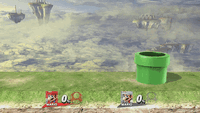
|
|---|
Taunts
- Up taunt: Transforms into Super Mario, as if he obtained a Super Mushroom, then shrinks back to normal size afterwards. The pose Mario makes when he performs the taunt is based on his standing pose in Super Mario Bros. This taunt increases Mario's hurtbox.
- Side taunt: Twirls around and takes off his hat, saying "Woohoo!" with either
 a surprised expression or
a surprised expression or  with a stern expression, then puts his hat back on. It resembles his level clear animation from New Super Mario Bros.
with a stern expression, then puts his hat back on. It resembles his level clear animation from New Super Mario Bros. - Down taunt: Spins in the air and falls to the ground with his legs in the air. This is a reference to his dying animation from Donkey Kong.
| Up taunt | Side taunt | Down taunt |
|---|---|---|
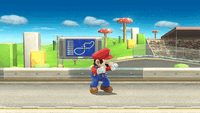
|
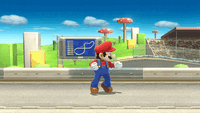
|
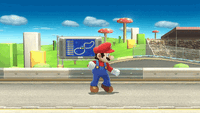
|
Idle poses
- Moves his head from left to right and holds his fist in front of his face.
- Adjusts his hat.
 |
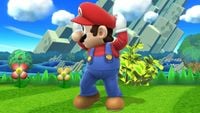
|
|---|
Crowd cheer
| English | Japanese | |
|---|---|---|
| Cheer | ||
| Description | Ma-Ri-O! | Ma-Ri-O! |
| Pitch | Group chant | Group chant |
Victory poses
- Winds up for a punch and steps forward while punching in front of the screen.
- Makes fire explode from his palm and strikes a pose.
- Does a short spinning jump and lands in a strongman pose. It originates from his "character chosen" animation in Super Smash Bros.
 |
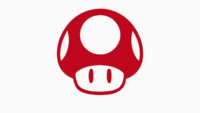 |
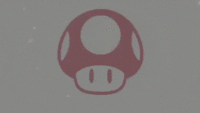
|
|---|
In competitive play
Official Custom Moveset Project
| Character | Custom sets available | ||||
|---|---|---|---|---|---|
| 2312 | 2332 | 2212 | 2232 | 1312 | |
| 1313 | 1332 | 1212 | 1213 | 2213 | |
Notable players
Active
bAhuto - One of Japan's best Mario players, placed 5th at Umebura 28 and 4th at Umebura 30. Has wins on players such as Kirihara, T, Eim, and Lea.
Big D - The best player from British Columbia, and consistently ranked #1 on the Vancouver PR. Known originally as the best Dedede player in the world, he now mains Mario along with Captain Falcon.
Blacktwins - The second best Mario player in Canada (behind Ally), 3rd at Get On My Level 2015, 1st place at Nexus 2, ranked 1st on the Southern Ontario Power Rankings.
Dark Wizzy - One of the best players in all of upstate New York. Considered to be one of the best Mario players in the world. Ranked 1st on the New York Capital Region Power Rankings, 25th at Super Smash Con 2016. His most notable wins are WaDi, ESAM and Zinoto.
FILIP - One of Japan's best Mario players, consistently places Top 8 at national Japanese tournaments, ranked 13th on the Umebura Smash 4 Power Rankings.
Gomakenpi - One of the best Mario players in the Midwest. Ranked 4th on the Michigan State University Power Rankings. Has taken a game off Ally.
JDB - One of the best Mario players in the Midwest. Currently ranked 1st on the Smash 4 Kentucky Power Rankings. He notably defeated ESAM and Tyroy at Midwest Mayhem 5.
Lui$ - One of the best Mario players in the United States. Placed 1st at GameTyrant Expo 2018, 33rd at EVO 2018 and 13rd at SCR 2018. Ranked 1st on the NorCal Smash 4 Power Rankings. Has wins over Captain L, Locus, Charlie, Nietono, Diablo, PiXL, IcyMist and Pandarian.
MastaMario - Considered the second best Mario player in SoCal (behind Zenyou). Formerly ranked 18th on the SoCal Smash 4 Power Rankings. Has wins on Manny, Charliedaking, and K9sbruce.
RoguePenguin - The best Mario main in Florida. Ranked 1st on the Gainesville Power Rankings.
Ron - One of Japan's best Mario players, the best Wi-Fi Mario player in Japan, 2nd at Sumabato 12.
SilentRain - One of the best SoCal Mario players. Formerly ranked 1st on the Oregon Power Rankings. Has wins over Larry Lurr, Vinnie and Nicko.
Super Dan - One of the best Mario players in the Midwest. Currently ranked 10th on the Midwest Power Rankings and 4th on the Chicago Power Rankings. Has wins over Ned, Tyroy, Ksev, Tearbear, JJROCKETS, and Karna.
Teb - Formerly ranked 7th on the NorCal Smash 4 Power Rankings, defeated ESAM very early in GENESIS 3 pools.
vyQ - Ranked 1st on the Austria Smash 4 Power Rankings. One of Europe's best players, placing 9th at B.E.A.S.T 6.
Zenyou - The best solo Mario player in the United States and currently the best active one after one of the two best ones retired, 33rd at EVO 2017, 13th at GameTyrant Expo 2017, 33rd at 2GGC: MkLeo Saga and 9th at [[Tournament:
GENESIS 5| GENESIS 5]]. He is also ranked 43th on the Panada Global Rankings v5.
Inactive
Ally - The best Mario player of all time and one of the two best ones after ZeRo's retirement, 1st at EVO 2016, Get On My Level 2016, and 2GGC: Greninja Saga, ranked 1st on the Montreal Smash 4 Power Rankings and 33rd on the Panda Global Rankings v5.
ANTi - The highest ranked Mario player in the world after ZeRo's retirement, 1st at CEO 2016 and Get On My Level 2017, 2nd at The Big House 6, ranked 17th on the Panda Global Rankings v5.
Mew2King - 3rd at PAX Prime 2015.
RFang - Placed 13th at MomoCon 2017, currently ranked 2nd on the South Carolina Power Rankings. Now mainly use Bayonetta.
Rice - Ranked 2nd on the NorCal Smash 4 Power Rankings.
smasher1001 - One of the best Mario players in the Midwest. Currently ranked 7th on the Michigan Smash 4 Power Rankings. Now mainly use Mega Man only.
Xzax - 17th place at Apex 2015, 25th place at Paragon Los Angeles 2015, which contributed to him being ranked 39th place on the Panda Global SSB4 Rankings. His last major use of Mario in singles was at 2GGT: Fresh Saga where he defeated Aphro's Bayonetta. Now uses the character for doubles play only.
Tier placement and history
Upon the game's release players immediately noticed the significant buffs Mario had received to his mobility, combo game, and most notably his KO power and reach. Meanwhile, although not a direct consequence, his tougher matchups from Brawl such as Marth, Meta Knight, and King Dedede were nerfed (especially with the former two's range reduced; the lack of range was Mario's critical flaw in Brawl). These buffs and the less hostile competitive environment caused Mario to be viewed as a viable character unlike in Brawl, where he is ranked as a low-tier character. The result of these buffs was a character with the lowest learning curve of any character in the game, who provides high reward for little effort, with caveats including great all-around mobility, a powerful, yet easy combo game, a useful zoning tool in his Fireballs, outstanding frame data that, in some cases, can leave him near-unpunishable (letting him abuse otherwise unsafe moves like charged smash attacks), and a strong recovery aided by a Cape that also works as a reflector. While some of these strengths were not perceived until much later, these caused him to quickly gain good tournament representation in all levels of play, and was considered a mid to high-tier character. Despite this, opinions of Mario slowly began to rise due to the fact he remained stagnant in game updates, as well as the nerfs to Diddy Kong, who was one of his most troublesome matchups. As a result of this, he started to gain much higher representation and results, especially by top players such as Ally and ANTi, both of whom have placed among the top 8 in large tournaments such as The Big House 5, with ANTi also taking top player ZeRo through very close games in the former tournament. This resulted in Mario ranking 8th on the first 4BR tier list.
On the earlier half of 2016, Mario's already strong results would significantly improve. Game updates would nerf Sheik, Zero Suit Samus and Bayonetta, some of his most difficult matchups, while Mario himself remained unchanged. Although it was unknown how these nerfs to the top tiers would affect him at first, it later became clear many characters (and players themselves) started to have a hard time fighting even inexperienced Marios. Furthermore, Ally would go on to win Get On My Level 2016, Smash 'N' Splash 2 and EVO 2016 using Mario (the latter being the largest Smash 4 tournament to date), while ANTi won CEO 2016 using Mario for the majority of the tournament (although he only won games with Cloud in Grand Finals). Due to this streak of successes, players would go on to say Mario was among the Top 5 characters in the game, which would coincidentally be reflected in him rising to 5th place on the second tier list, officially entering the highest tier. On the third tier list, Mario suffered a very slight drop to 6th place and the A tier, as while he remained a very successful character, his results had dropped compared to Summer 2016, and this drop also paved the way for Bayonetta to claim the 1st place. Despite this, many players argued that Mario still deserved a Top 5 ranking due to his spectacular prior results, and the tier list also marked the first time he surpassed Rosalina & Luma as the highest-ranked Mario character.
Recently, however, Mario's top level results have become noticeably worse than some top tier characters such as Fox, Marth, Ryu, Sonic and Zero Suit Samus, all of whom have received stronger tournament representation and results. Players also eventually learned that some of his even or disadvantageous matchups lurked in the lower tiers and do a solid job at exploiting Mario's below average range, with Corrin, Donkey Kong, and Lucina being particular examples. As a result, Mario's decline in tournament results saw him drop to 9th place on the fourth and current tier list. Regardless, it is certain that Mario is by far the most improved veteran from Brawl to Smash 4.
Trophies
- Mario
As iconic as iconic gets, this gaming celebrity is known for saving the world from Bowser. He's got amazing jumping skills and makes use of a wide range of transformations. In his free time, he plays too many sports to count. In Smash Bros., he's a well-rounded fighter you can rely on. Say it with me: "It's-a me, Mario!"
It's-a him! Maaario! Whether he's wearing one of his special outfits or just his normal blue dungarees, this running, jumping, Bowser-bashing, princess-saving hero is an all-round superstar. And in this game, he's got enough tricks up his sleeve to deal with anything. If you don't know which fighter to pick, Mario's a solid choice.
: Donkey Kong Classics 09/1988
: Super Mario Bros. 10/1985
- Mario (Alt.)
Mario's Super Jump Punch takes you high into the air, and if you catch an opponent with it, they'll go up with you. Try to hit them at the very start of the move to do the most damage. His default side special, Cape, can flip fighters around. If you're really crafty, you can even use it to keep someone from getting back on the stage!
: Donkey Kong Classics 09/1988
: Super Mario Bros. 10/1985
- Mario Finale
Break the Smash Ball and unleash Mario's Final Smash. Mario will fire a devastating blast of fire in the direction he's facing. The attack covers a wide range and travels far, so it's best to fire this from one side of the stage to the other. The damage is impressive, and it can actually carry foes right off the screen!
When Mario gets his hands on a Smash Ball, he can activate this Final Smash. Flames spiral outwards in two intertwining stream, catching opponents in the wide blast with ease. It deals plenty of damage, and can also push foes off the screen entirely. Fire it from an elevated position to take full advantage of its vertical range!
In Event Matches
Solo Events
- All-Star Battle: Regulars: Mario is one of the opponents fought in this event. All opponents are starters from the original Super Smash Bros. game.
- Below the Belt: Mario must protect a damaged Little Mac from a giant Little Mac.
- Family Ties: The player controls Bowser Jr., who is aided by a giant Bowser, and must defeat Mario and Luigi.
- Oh Yeah, Luigi Time!: A giant Mario serves as an ally to Luigi, who must defeat a giant Wario.
- Princess Punch-Up!: Mario and Peach are opponents in a stock battle against Zelda and Link.
- The FINAL Final Battle: The player must defeat Mario, alongside Sonic, Mega Man, and Pac-Man.
- The Original Heavyweights: Mario must defeat Bowser and Donkey Kong.
- Wrecking Mario: Mario must destroy all of the building on Wrecking Crew.
Co-op Events
- 1988: Donkey Kong and Diddy Kong must defeat 3 Marios, each one larger than the last.
- A Lurking Menace: Mario and Luigi must defeat Bowser Jr. After some time, a giant Bowser will appear and the players must defeat him as well.
- Flat Fracas: A shadow Mario and a giant shadow Donkey Kong are opponents fought by Wario and Mr. Game & Watch.
- Solidarity: Olimar and Rosalina & Luma must defeat Mario and Luigi. When they are defeated, Bowser and Bowser Jr. must be defeated as well.
- The Ultimate Battle: Two players select a character and must defeat the entire roster.
- Wrecking Bros.: Mario and Luigi must destroy all of the building on Wrecking Crew. Wario and King Dedede will try to stop the players.
Alternate costumes

| |||||||

|

|

|

|

|

|

|

|
Gallery
Mario's amiibo.
Cape.
Mario and Luigi jumping.
Mario, Sonic, and Mega Man on Battlefield.
Mario meteor smashes Kirby with his forward aerial.
Mario, Pikachu, Bowser and Pit on a red plane in Wuhu Island.
Mario's Fireball colliding with Sonic's neutral attack.
Mario's F.L.U.D.D. being deflected by Rosalina.
Mario in Smash Run.
Mario air dodging with Mega Man.
Mario jumping with the Wii Fit Trainer
Fox jumping near Mario.
Mario and an Orne in the 3DS version.
F.L.U.D.D. in Super Smash Bros. for Nintendo 3DS.
Trivia
- While Mario’s artwork has a him holding a fireball in his official artwork on the website, amiibo model, and trophy, his artwork on the character select screen and during a match shows him without it.
- Because of this, there is no official artwork of any of Mario’s alternate coatumes with said fireball
- A glitch from 1.0.7 shows when Mario performs his side taunt on Ω Gerudo Valley, his hair is missing when taking off his cap, revealing the inside of his head.
- The original project proposal for Smash 4 stated that the fighters would have four custom special moves instead of the three that are in the final game. Mario was used as an example. The unused special move in the proposal would've had Mario release two fireballs for his neutral special instead of one.[4]
- Dr. Mario was originally going to be an alternate costume for Mario, but was instead developed as a separate character in favor of retaining Dr. Mario's unique traits from Melee.Cite error: Invalid
<ref>tag; invalid names, e.g. too many - Mario is present on more newcomer posters than any other fighter. He appears in eleven promotional posters, namely for Villager, Wii Fit Trainer, Rosalina & Luma, Greninja, Robin, Bowser Jr., Duck Hunt, Mega Man, Pac-Man, Cloud, and Corrin. [5]
- Mario is required to be used in 3 solo events, more than all other characters.
- He and Luigi are also the only pair to be in more than 1 co-op event together.
- Mario's alternate trophy in Super Smash Bros. for Wii U resembles his Adventure Mode trophy in Melee.
- Mario, Toon Link and Duck Hunt are the only characters in the 3DS version whose Star KO screams can be heard when their tokens are KO'd in StreetSmash.
- This marks the latest appearance of Mario's Wario-based alternate costume worn since the original Super Smash Bros.
References
- ^ Super Smash Bros. for 3DS/Wii U 1st Trailer
- ^ Wii U & Nintendo 3DS Developer Direct - Super Smash Bros. for Nintendo 3DS and Wii U @E3 2013
- ^ Nintendo Treehouse: Live @ E3 2014 -- Day 2: Super Smash Bros. for Wii U
- ^ Image Transcriptions of Project Proposal for Smash for Wii U/3DS
- ^ Official Site - Super Smash Bros. for Nintendo 3DS / Wii U
| Fighters in Super Smash Bros. 4 | |
|---|---|
| Veterans | Bowser · Captain Falcon · Charizard · Diddy Kong · Donkey Kong · Dr. Mario · Falco · Fox · Ganondorf · Ike · Jigglypuff · King Dedede · Kirby · Link · Lucario · Lucas · Luigi · Mario · Marth · Meta Knight · Mewtwo · Mr. Game & Watch · Ness · Olimar · Peach · Pikachu · Pit · R.O.B. · Roy · Samus · Sheik · Sonic · Toon Link · Wario · Yoshi · Zelda · Zero Suit Samus |
| Newcomers | Bayonetta · Bowser Jr. · Cloud · Corrin · Dark Pit · Duck Hunt · Greninja · Little Mac · Lucina · Mega Man · Mii Fighter (Mii Brawler · Mii Gunner · Mii Swordfighter) · Pac-Man · Palutena · Robin · Rosalina & Luma · Ryu · Shulk · Villager · Wii Fit Trainer |
